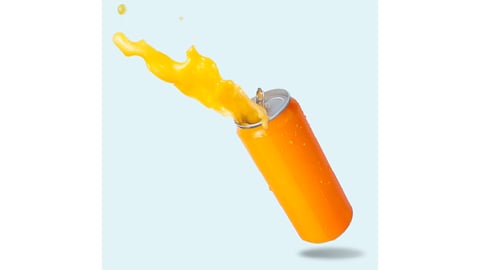How grocers can prepare for Ontario's alcohol expansion
Grocery retailers thought they had time to develop a strategy before the beverage alcohol category expanding in Ontario.
But in May, the plan by the Doug Ford government to allow alcohol sales in all grocery stores by 2026 was put on the fast-track.
Beginning Aug. 1, the 450 grocery stores currently licensed to sell beer, cider and wine can start selling ready-to-drink (RTD) alcohol products. Ontario’s gross revenue from alcohol sales totalled $7.41 billion in 2023, according to a 2022-23 report from the LCBO. The RTD segment represents 9.1% of the revenue, having increased year-over-year by 6.8%. (By comparison, sales of wine fell 3.1% while beer slipped 1%.)
Retail prices will remain fixed until September, but grocers will also have a wider assortment to order from, including large-format beer (12-packs, 24-packs, and even larger formats).
On Sept. 5, convenience stores can start selling beer, cider, wine and ready-to-drink alcoholic beverages, further expanding the competition. The final milestone in the province’s phased expansion and rollout comes on Oct. 31, when all supermarkets and grocery stores can sell beverage alcohol.
READ: Ontario’s decision to expand beer, wine sales levels playing field for grocers
While an accelerated timeline might seem like a positive development, Canadian Grocer reached out to more than half a dozen grocery chains about their plans and those who responded were non-committal. “We’re still in the early stages of exploring this market and have not yet decided on our next steps,” said one major chain, which didn’t want to be named.
A number of them directed interview requests to the Retail Council of Canada (RCC).
Michelle Wasylyshen, national spokeswoman for the RCC, said its grocery retail members have major concerns.
“Grocers are concerned that Ontario’s rapid expansion will cause delayed orders, lower fulfillment rate and potentially stockouts,” she tells Canadian Grocer. “While these growth pains are understandable, some grocers may take a wait-and-see approach to expanding their number of licensed locations in order to ensure that supply can actually keep up with demand.”
She says other drawbacks to the province’s model include rules prohibiting the creation of private-label alcohol beverage products. Grocery retailers are also prohibited from receiving supplier monies, promotional material or other trade inducements. “Grocers can never be the low cost-leader,” underscores Wasylyshen.
Another hurdle? “The requirement for grocery stores to operate a return-to-retail recycling system for alcohol containers,” says Wasylyshen. “Operating return-to-retail systems are incredibly expensive, take up valuable floor and backroom space and create health and safety concerns for staff.”
In other Canadian jurisdictions, like British Columbia, she says health and safety regulators have advised against “crushing glass in retail settings because of noise and other concerns associated with small glass particles, particularly in and around food products.”
“Based on preliminary calculations using return-to-retail costs from other Canadian jurisdictions, operating a deposit return system (DRS) will offset any profit the retailer would otherwise make on the category,” states Wasylyshen.
If that isn’t enough to consider, “there is also the question of equipment,” says Veronique Morin, director of advanced analytics at NIQ, North America. “Refrigerated spaces are a premium in grocery stores and can't necessarily be added easily or inexpensively, so before going all-in, retailers should take careful consideration.”
Other categories and/or product SKUs would also have to be scaled back or eliminated to make room for added refrigeration space.
In making these decisions, “margins should be criteria, but grocers should also keep the needs of the consumer in mind and make sure they're not removing products that attract shoppers to their stores,” says Morin. “The risk of delisting an item that brings high incremental sales to the store might be far greater than adding an additional item to shelves, especially early on, as we are not sure yet how shopper behaviours are going to shift once the distribution expands.”
“To limit sales losses and drive the most value out of the beverage alcohol introduction,” she says careful analysis has to go into rationing any product.
READ: The food and beverage trends that could get sales sizzling this summer
In fact, before doing anything, she recommends grocers first assess “what role they intend the beverage alcohol category to play for their business.”
For instance, if you want to compete as a destination for beverage alcohol, “variety is key” as opposed to a “leaner assortment,” says Morin. “With 74% of Ontario residents being beverage alcohol consumers, deciding not to carry a sufficient assortment of products closes the door on a large market of shoppers.”
“There are gold items that everyone needs to carry, but the rest of the assortment consideration should be based on category role and regionalities, which is important for beverage alcohol,” she adds. “Many smaller items have a role to play in making a store a viable destination for shoppers. In Quebec, where the grocery channel is already very developed for beverage alcohol and where the average store carries four times more items than the average Ontario store, NIQ models are showing that retailers' sales would benefit from expanding their assortment.”
NIQ studies also indicate that “beverage alcohol products are an important traffic driver, and with [weekly grocery] trips on the decline in the past few years, leveraging categories that can bring shoppers in retailers’ stores should be a clear focus.”
“It's even more important to satisfy the needs of the beverage alcohol shopper, given that these products are often consumed more frequently and in greater quantities during holidays and special events, when the rest of the basket tends to be larger, too,” she adds.
Four tips for the ideal mix
Morin says one of the biggest challenges for Ontario grocery retailers in the expanding beverage alcohol category is deciding what products to list.
Below, she shares some top considerations.
Competition
Located near a bigger retailer? You’d potentially face lower initial foot traffic as consumers may be less inclined to change where they make alcohol purchases. “Differentiating your assortment from the stores nearby might help to encourage trial in your stores,” she says. “But you also want to carry the must-have items so that your shoppers see you as an easy one-stop shop.”
Demographics
Beverage alcohol consumption and product choices are highly influenced by age, income and origin. “With this, shelf assortment should be adapted to the population living nearby,” says Morin. “This can also change depending on the time of the year.” Think cottage season, when some regions of the province see an influx of a new demographic profile.
Think local
While individual microbreweries might be a small share of the total beverage alcohol market, “the demand can be sizable around their location. Not considering their product could irritate some consumers and limit sales, since these products can bring significant incrementality.”
However, Morin says grocers should balance supply with actual demand, as well as the potential complexity that multiple suppliers can bring to the supply chain. “The fact that a brand is local is not sufficient to consider bringing them in—ask them to do their homework and demonstrate the value that their products can bring to your shelf.”
Pricing
Resist discounting to start. “Offering the lowest price might not be possible to drive acceptable margins, at least in the first years,” says Morin, citing the “limited ability” of retailers to negotiate prices. “However, beverage alcohol products are typically price-sensitive when the retail market is competitive, so identifying the key items that generate price lift will be a must to drive sales.




